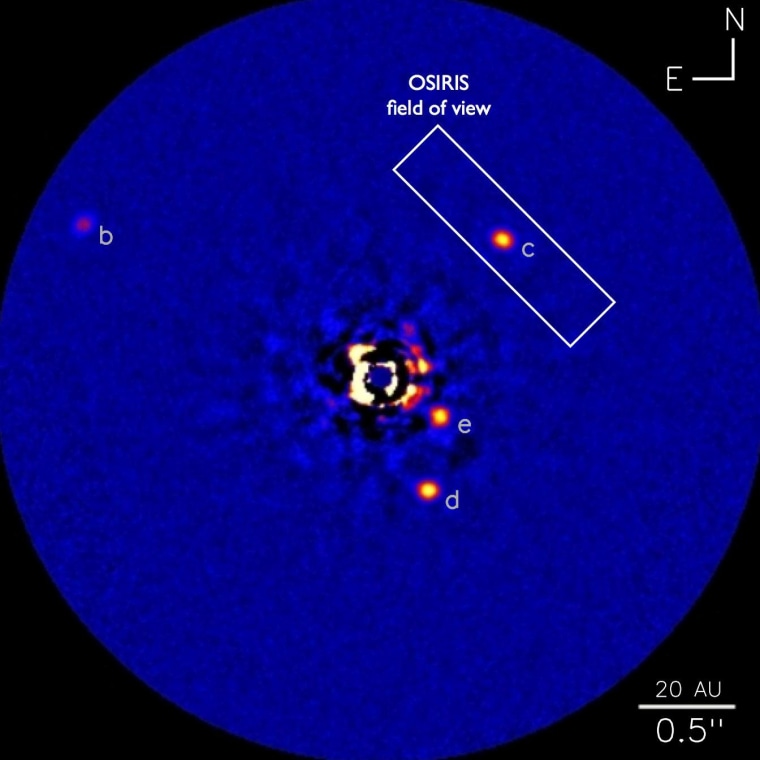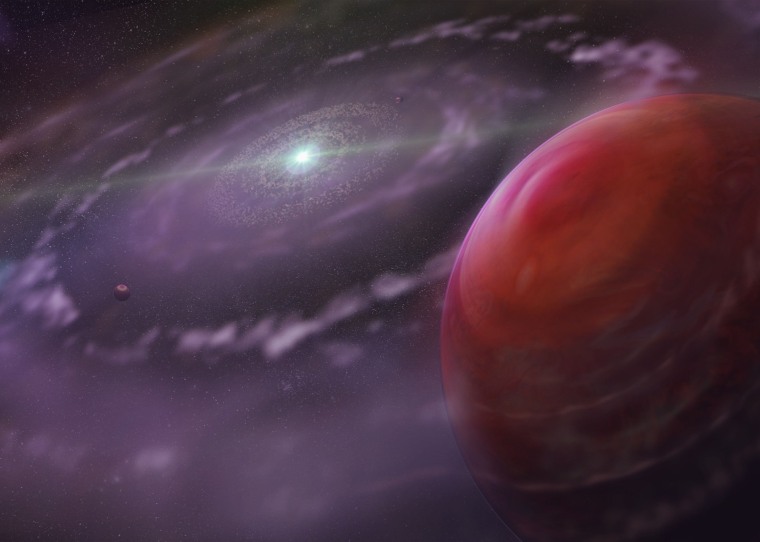Astronomers say they've confirmed the presence of water vapor and carbon monoxide in the atmosphere of a giant planet beyond our solar system, thanks to the most detailed spectroscopic scan ever made.
The observations, detailed Thursday on the journal Science's website, uses a method that could someday be used to sample the air of an alien Earth from light-years away, the researchers said.
"The big surprise was actually that we could do it," one of the study's co-authors, Travis Barman of the Lowell Observatory in Arizona, told reporters. "We can actually see the individual lines of these molecules. ... I personally felt like we would not be able to do what we have done."
This isn't the first time scientists have studied the atmosphere of HR 8799c, a planet about seven times as massive as Jupiter that orbits a star 130 light-years from Earth. The HR 8799 system is special because astronomers can actually pick up the light of several giant planets that orbit outside the glare of their parent star. HR 8799c, for example, follows an orbit similar to the one Pluto traces around our own sun.
That's what makes it possible for astronomers to get the "chemical fingerprint" of the planet's atmosphere. One team did it three years ago with an instrument on the European Southern Observatory's Very Large Telescope in Chile. Another team reported just this week that they did it for four planets in the HR 8799 system using an instrument known as Project 1640 on the Palomar Observatory's Hale Telescope in California.
Higher resolution
Barman and his colleagues said they used the OSIRIS spectrograph on the Keck II telescope in Hawaii to produce a chemical fingerprint with enough resolution to determine which chemicals were present in the atmosphere, and which were not.
They found that the planet had a cloudy atmosphere containing water vapor and carbon monoxide — but not methane, as some researchers had previously suspected. Methane is an ingredient in the atmospheres of our own solar system's giant planets.

HR 8799c isn't a likely candidate to harbor life as we know it. It's far too gassy and hot, with a surface temperature of 1,800 degrees Fahrenheit, or 1,000 degrees Celsius. But the same spectroscopic method could theoretically be used to analyze the atmospheres of Earthlike planets for signs of life — if the telescope could be made big enough.
"If you wanted to do an Earth-sized planet, you really need a spacecraft, and you really need a very dedicated spacecraft that was designed only for that purpose," said another co-author of the Science study, Bruce Macintosh of the Lawrence Livermore National Laboratory in California.
Barman said it might be possible to detect variations in the surface brightness of extrasolar planets using next-generation, ground-based instruments such as the Gemini Planet Imager. "We might be able to do that within the next few years," he said.
How were planets formed?
The researchers said the readings from OSIRIS also could provide insights into how the planetary system was formed. Theorists have proposed two scenarios for the formation of planets from the disk of gas and dust surrounding an infant star. In the core-accretion scenario, planets form gradually as solid cores grow massive enough to start taking on envelopes of gas from the disk. In the gravitational-instability scenario, planets form almost instantly as parts of the disk collapse on themselves.
"For the first time, we can actually make a statement, a suggestion about the way the system might have formed, which is an extremely difficult thing to do observationally," said the study's lead author, Quinn Konopacky, an astronomer at the University of Toronto's Dunlap Institute for Astronomy and Astrophysics.
The ratio of carbon to oxygen was higher than would have been expected if the planet shared the composition of its parent star and protoplanetary disk. That might have happened because the disk's gas cooled gradually over time, forming water ice that depleted the oxygen from the gas that remained. This is the way most astronomers believe our own solar system formed.
"Once the solid cores grew large enough, their gravity quickly attracted surrounding gas to become the massive planets we see today," Konopacky said in a news release. "Since that gas had lost some of its oxygen, the planet ends up with less oxygen and less water than if it had formed through a gravitational instability."
Not all astronomers think the case is that clear-cut, however. Alan Boss, a theoretical astrophysicist at the Washington-based Carnegie Institution for Science, told NBC News that giant planets as far away from their parent stars as HR 8799c were more likely to be formed through gravitational instability than through core accretion.
In any case, Boss said he doubted that the readings from OSIRIS could rule out either scenario for planetary formation, since so much depends on the details of a particular theory. "Theorists are clever," he said. "It's hard to paint them into a corner."
More about planets:
- Sun's shock waves may have staggered planet formation
- Cosmic wreckage hints at our planet's eventual fate
- NBC News archive on planetary science
The authors of the Science study, "Detection of Carbon Monoxide and Water Absorption Lines in an Exoplanet Atmosphere," include Christian Marois as well as Konopacky, Barman and Macintosh.
Alan Boyle is NBCNews.com's science editor. Connect with the Cosmic Log community by "liking" the log's Facebook page, following @b0yle on Twitter and adding the Cosmic Log page to your Google+ presence. To keep up with Cosmic Log as well as NBCNews.com's other stories about science and space, sign up for the Tech & Science newsletter, delivered to your email in-box every weekday. You can also check out "The Case for Pluto," my book about the controversial dwarf planet and the search for new worlds.
